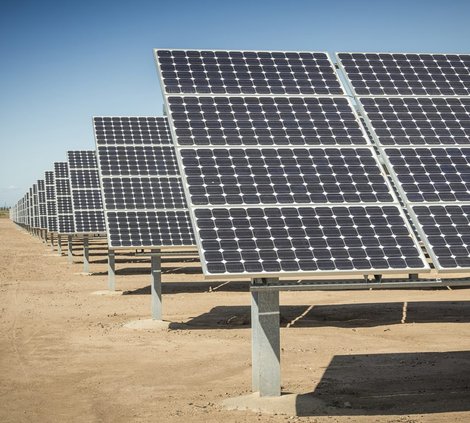The sun is rising as a brilliant orange against the eastern skies over John Muir’s beloved Range of Light.
Below in the Northern San Joaquin Valley, the morning breeze gentle rustles pasture grass as rows upon rows of black panels get ready to go to work.
Computers measure the sunlight.
Massive black panels encasing solar cells designed to harness the ultimate renewable resource of ultraviolet rays start tracking the sun.
The Robert Schulz Solar Farm generates 1.6 megawatts of clean energy to power the nearby Nick DeGroot South County Surface Water Treatment Plant located 16 miles northeast of Manteca.
Not a single ounce of any type of pollution is emitted to disturb the grazing of nearby cows.
The solar farm does it with a slight whirl and a click at the control panels in the middle of the farm that are inaudible unless you are standing right next to it.
It is here less than a half mile from the depression amid roiling hills where Walter Woodward camped to survey out the reservoir that carries his name 105 years ago that the ground work was laid for the South San Joaquin Irrigation District’s second century of service to the communities of Manteca, Ripon, and Lathrop.
The solar farm completed in 2009 was both part of the promise and the vision that today’s SSJID’s leaders are shaping to build on the legacy of the pioneers who had the foresight to secure, protect, and deliver water to transform the South County into a prosperous landscape of farms and cities.
The solar farm in most years wipes out the energy bill the district had been paying PG&E on behalf of the three cities that secure treated water from the adjoining plant – Manteca, Lathrop, and Tracy.
The 220,000 urban residents that get part of their drinking water from the SSJID surface water treatment plant are also assured the portion of their respective municipal water bills that covers electrical costs to run the treatment plant will always be at least 15 percent less than what PG&E would charge.
And that’s thanks to the SSJID solar farm.
That is part of the SSJID mantra in its bid to acquire the local PG&E distribution center – to reduce energy bills across-the-board for farmers, urban dwellers, employment centers, and businesses in Manteca, Ripon, and Escalon by 15 percent.
It is about harnessing the Tri-Dam Project profits that SSJID receives from selling wholesale electricity to benefit the entire district.
The solar farm, in a way, is as visionary as the original formation of the district.
The second phase at the time it was completed by ConEnergy was the world’s first single-axis solar tracking system employing thin-film photovoltaic cells.
The technology in 2009 was considered cutting edge as it maximizes power production on cloudy and hazy days.
It can literally be a boon in the typically sunny Central Valley where air pollution, dust, and clouds often reduce maximum solar efficiencies compared to more ideal sites in the California high desert provide.
The solar farm – coupled with hydroelectric plants on the Stanislaus River, and one at the base of Woodward Reservoir — makes SSJID a 100 percent green energy producer.
It is one of the ways the SSJID board is trying to share the benefits of the Tri-Dam Project – a series of three dams and hydro plants built 66 years ago along the Stanislaus River — throughout the district.
The district already has one of the most secure water rights in the state plus what is either the lowest – or close to it – irrigation rates for farm uses.
The district’s next step is to acquire the PG&E retail system to reduce power costs to individuals, businesses, and farmers at least 15 percent across the board. That process is currently working is way through the San Joaquin County Superior Court system.
Board discussing whether
to make repower to solar farm
Today, the SSJID board will decide when they meet at 9 a.m. at the district office whether to repower the solar farm.
The original $12 million investment made 16 years ago has paid for itself.
In addition, it has provided energy savings in the neighborhood of $750,000 a year — a figure that has become somewhat unreliable due to the aging of the system,.
The proposal before the board involves a $3 million contract with NuLife that takes advantage of $1.25 million in solar farm equipment bought from the City of Manteca for its wastewater treatment plant but bever installed.
A simple analysis that takes the cost of $4.25 million in repowering, weights increased PG&E tariffs and lower consumption at the treatment plant means it will take five years to pay back the investment.
That’s because the repowering will result in $1 million in annual energy savings.
The savings means the three cities that use SSJID surface water — Manteca, Tracy, and Lathrop — will proportionately save that much money in pass through energy costs that are factored into the treatment plant’s treatment of water
To contact Dennis Wyatt, email dwyatt@mantecabulletin.com





